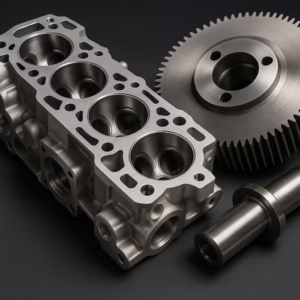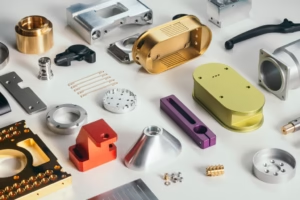Common Materials Used In CNC Projects
CNC (Computer Numerical Control) machining has existed for decades and is more popular than ever. Thanks to technological advances and the availability of superior metal alloys, including superalloys. There is a wide range of CNC machining providers available, from in-house machining services to outsourced manufacturers and innovative on-demand CNC machining ecosystems.
CNC machining is versatile, and suitable for various applications ranging from hobby projects to prototype development and large-scale, high-volume production. It offers high precision, requires minimal manual labor, and delivers excellent quality.
When choosing to have a component CNC machined, several important factors must be considered. Including material selection, tolerance requirements, geometric constraints, post-processing operations, and quality inspection guidelines. Material selection can be particularly challenging due to the complex interactions between metals and their environments. Their response to applied loads, and the extensive selection of high-quality materials available to engineers. As a result, navigating CNC material selection can be overwhelming.
Materials Selection Steps
Selecting the right material is crucial in CNC machining projects. It can enhance machining accuracy, optimize production cycles, and reduce overall costs. Proper material selection can also ensure product quality, machining efficiency, and cost-effectiveness.
Here are the main steps to follow in the material selection process for CNC machining projects:
Clarify Project Requirements
– Functional Requirements: Define the functional needs of the part or product. Consider characteristics such as high-temperature resistance, corrosion resistance, and fatigue resistance.
– Mechanical Properties: Assess the material’s strength, hardness, ductility, and wear resistance to ensure it can withstand the stresses and loads encountered during use.
– Dimensional Accuracy: If the part requires high precision, the material’s machinability and stability are essential.
– Surface Quality: For parts that need a good surface finish, selecting the right material and surface treatment process is critical.
Analyze the Impact of Machining Methods
-CNC Machining Process Requirements: Different machining methods (e.g., milling, turning, drilling) have varying impacts depending on the material. Some materials may be difficult to machine or could cause tools to wear out quickly.
– Cutting Performance: Consider the material’s hardness, cutting temperature, and tool life, as these factors significantly affect machining efficiency. Opt for materials that are easy to machine with excellent cutting performance.
Physical Properties of Materials
– Hardness: Harder materials typically require greater cutting forces and more robust tools, whereas softer materials are easier to process.
-Coefficient of Thermal Expansion: For precision machining, materials that maintain stable shapes during temperature changes are ideal. Thus, materials with a lower coefficient of thermal expansion may be preferred.
– Thermal and Electrical Conductivity: Depending on the product’s working environment, the thermal and electrical conductivity of the material may need to be taken into account.
Cost Control
– Material Cost: Market prices for different materials can vary significantly, especially for alloys and specialized materials (such as titanium alloy, aluminum alloy, and carbon fiber).
– Processing Cost: Some high-hardness or specialized materials necessitate the use of special tools or may prolong processing time, leading to increased costs.
Environment and Use Conditions
– Working Environment: Evaluate the environment in which the product will operate. For instance, if the product will be exposed to high temperatures, high humidity, or corrosive conditions. Materials with corrosion-resistant or high-temperature properties should be selected.
– Environmental Sustainability: With increasing environmental protection standards, many industries are moving towards using eco-friendly or recyclable materials. By following these guidelines, you can make informed decisions during the material selection process in CNC machining projects.
Materials Suitable for CNC Machining
CNC machines can process a wide range of materials, depending on the specific application. Common metals used include aluminum, brass, copper, steel, and titanium. Additionally, non-metallic materials like wood, foam, fiberglass, and plastics (such as polypropylene, ABS, POM, PC, and nylon) are frequently machined. However, some materials are not suitable for CNC machining due to their physical properties. for instance, rubber and silicone are too flexible, while ceramics are too hard to machine with precision.
- Stainless Steel
There are a wide variety of alloys of stainless steel on the market today, and CNC machining applications tend to favor popular grades such as 304, 316, 416, and 17-4 PH stainless steels. Stainless steels are strong materials with naturally protective oxide layers which makes them an excellent choice for harsh environments. Their grades differ due to different alloying elements used – molybdenum increases corrosion resistance whereas sulfur improves its machinability in certain grades such as 303 stainless steel.
- Aluminium
Aluminum is an ideal material choice for CNC machined components due to its superior machinability, lightweight nature, strength, and high corrosion resistance. Aluminum alloys also boast excellent thermal and electrical conductivity properties which makes them suitable for applications in thermal management and electronics. When choosing between stainless steel and aluminum for CNC machining, take both cost considerations as well as your application requirements into account.
- Titan
Titanium alloys have become an indispensable choice for medical equipment and implantable components, including screws and devices. Furthermore, titanium is widely utilized by aerospace, industrial, and military industries due to its superior strength, creep resistance, and excellent metallurgical properties. Approximately twice as strong as aluminum but slightly more than half its density; popular in consumer products including lightweight golf clubs.
- Copper
Copper is an outstanding conductor of electricity and heat, second only to silver in terms of thermal and electrical conductivity. Unfortunately, pure copper (approximately 99% commercial purity) poses challenges to CNC machines due to its malleability at lower temperatures and considerable ductility. However, several copper alloys exist that offer similar or even better thermal and electrical properties than pure copper.
- Brass
Brass, an alloy of copper and zinc, shares many properties with copper. Known for its durability and ease of machining, brass is corrosion-resistant, electrically conductive, and features a low coefficient of friction qualities that make it suitable for many different uses such as plumbing, electrical work, artistic endeavors, and medical applications.
Applications of CNC-Machined Parts
CNC machining utilizes a variety of cutting tools to manufacture an extensive range of components, from marine and mechanical parts to aerospace components. These applications often require high-precision parts, including shafts, gears, bushings, flywheels, cams, molds, and propellers.
The products produced on CNC machines depend on the specific capabilities of the machine being used. Each type of CNC machine has distinct machining capabilities tailored to the manufacturing of unique components. For example, round or spherical parts that are created in a CNC turning center cannot be produced with a CNC milling machine.
CNC-Drehteile
In the CNC machining industry, CNC lathes are used to process straight cylinders, tapered cylinders, arcs, and various threads, grooves, and worms. These machines can also handle complex rotating surfaces, such as hyperboloids. Typical CNC turning parts include shift knobs, pulleys, shafts, hubs, bushings, and flywheels.
CNC Milling Parts
CNC milling machines are primarily used to work on intricate planes, curved surfaces, and housing components. Commonly machined parts using CNC milling include cams, molds, connecting rods, blades, propellers, and box- or housing-shaped components.
Limitations of CNC Machining
Despite the versatility of CNC machines, there are certain limitations regarding the types of parts that can be machined effectively:
- Inner Vertical Angles: Since CNC milling tools are cylindrical, they inevitably leave a radius on vertical angles when cutting inner walls. While the tip radius can be minimized by using a smaller diameter tool, it is impossible to achieve a perfect internal vertical angle, regardless of the tool size.
- Parts with Deep Cavities: Tools work best when cutting cavities that are 2-3 times their diameter. Machining cavities deeper than four times the tool diameter significantly increases the difficulty and risk of tool breakage.
- Thin-Walled Parts: Thin walls pose a challenge in CNC machining due to their tendency to deform or break. Machining thin walls requires multiple passes at low cutting depths, and thin features are prone to vibration, complicating the process and increasing machining time. Overall, understanding the capabilities and limitations of CNC machining is crucial for optimal part production.
If you have any needs, contact us via email at Lynnyao@prototekparts.com oder Telefon: +86-0792-86372550
Tags:
- CNC Projects Materials

























































